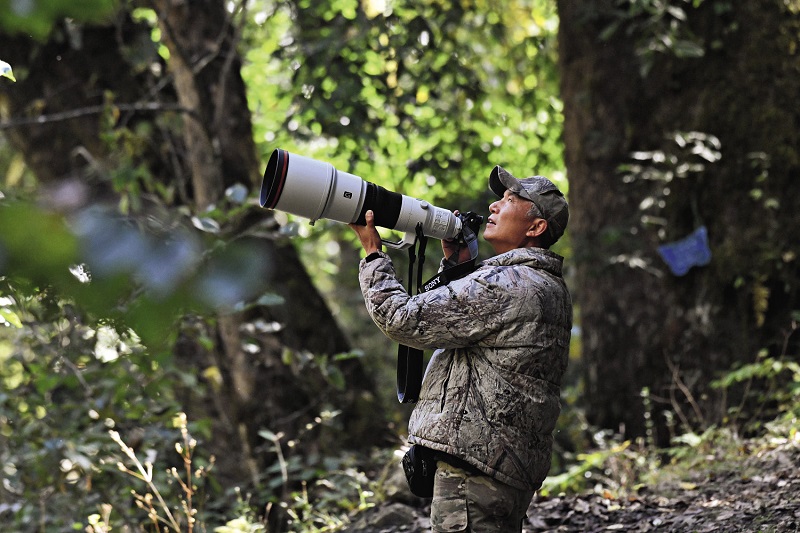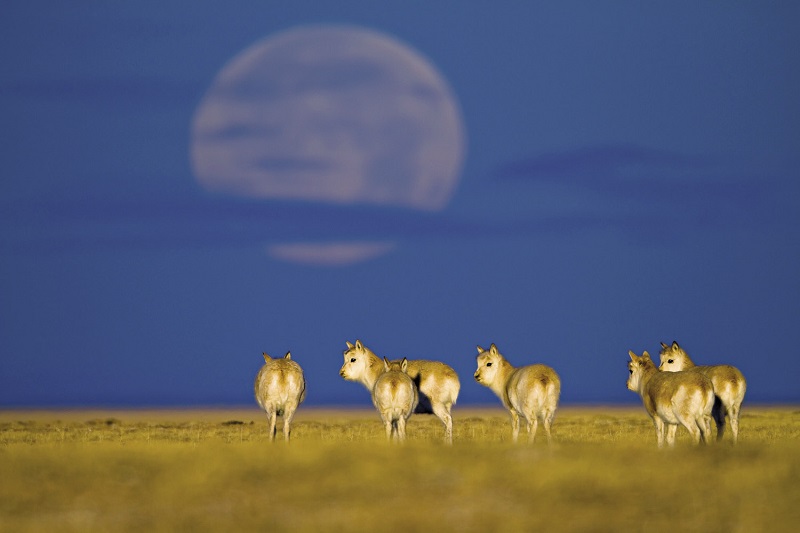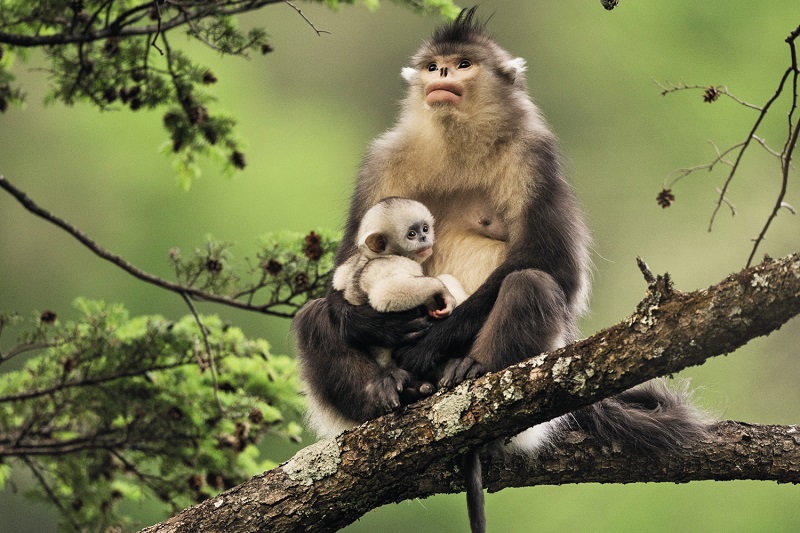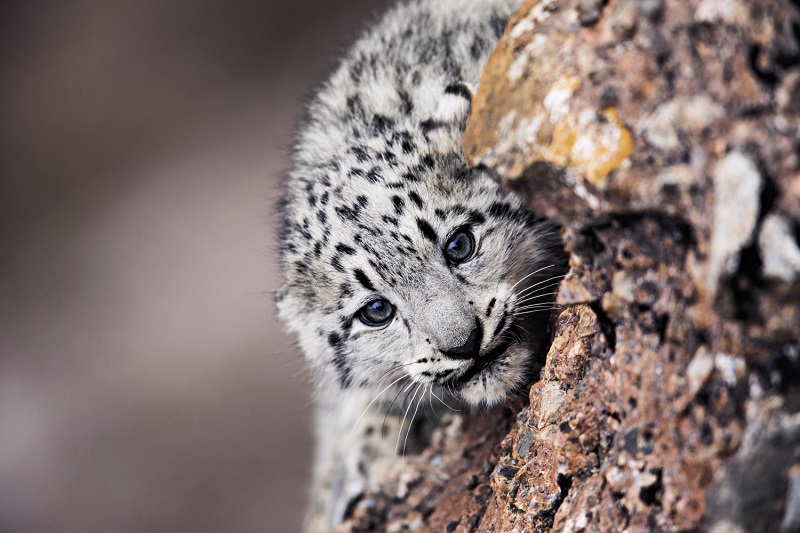
Xi Zhinong is pictured patiently waiting to capture a beautiful wildlife scene with his camera. Photo courtesy of Wild China Film
Xi Zhinong, 58, is a perky man with endless stories to tell. But the protagonists in his stories are always wild animals: free-flying birds over mountaintops or through the forests, distinctive-looking black-and-white Yunnan snub-nosed monkeys, Tibetan antelope in northwest China’s Hoh Xil Nature Reserve, or the elusive snow leopards in remote mountains.
Now, Xi wears many hats – founder of the Wild China Film, the first Chinese winner of the world-renowned Wildlife Photographer of the Year, and a member of the International League of Conservation Photographers.

Tibetan antelopes are standing in the early morning sunlight in Hoh Xil, Qinghai Province, January 1, 2010. Photo courtesy of Xi Zhinong
Northwest Yunnan: Beginning of a Dream
Xi was born in Weishan, a small town in Dali Bai Autonomous Prefecture, Yunnan Province. When he was young, he moved to Kunming with his mother. Feeling like a caged bird in big city, he was desperate to escape the hustle and bustle of city life and embrace nature again.
His chance soon came. In 1983, as a young man, he had the opportunity to serve as a camera assistant on a Yunnan University’s team for the shooting of a documentary Birds of Paradise. Due to limited photographic equipment, inadequate skills, and outdated technology, the team was unable to photograph the birds at a close range. That experience sparked in him a determination to learn photography and photograph birds in flight.
In the 1980s, the Internet was not that popular in China and photographic equipment was expensive and scarce in number. He managed to borrow a camera and threw himself into studying how to use it. The provincial library became his favorite place where he would spend days reading through every issue of the Chinese Nature magazine.
“Chinese Nature was launched in 1980, and it opened a door for me to come in closer contact with nature,” Xi said. The magazine, dedicated to improving scientific literacy among the public, introduced the living creatures of nature and rare species, and wrote about a wide range of topics including animal protection, scientific investigation, and the relationship between humans and the environment. These gave him his first lesson in ecological environmental protection and established a strong belief in the youngster’s heart to protect it.

A Yunnan snub-nosed monkey is cuddling her baby in Kunming, Yunnan Province. Photo courtesy of Xi Zhinong
Unraveling Mysteries of an Endangered Species
The Yunnan snub-nosed monkey is a unique animal species in China. They live in alpine coniferous forest zones at an altitude of more than 3,000 meters year round. Each family needs at least over 100 square kilometers for foraging and other activities. Due to the small size of the species’ population, in 2008, the Yunnan snub-nosed monkey was included in the list of endangered species by the International Union for Conservation of Nature.
From 1992 to 1995, a special research program was conducted in the Baima Snow Mountain Nature Reserve located in the northwest of Diqing Tibetan Autonomous Prefecture. The alpine virgin forest in the nature reserve is the home of these rarely seen monkeys. The normal half-a-year-long winters there created great challenges for the scientific research and filming work. Despite the difficulties, Xi never drew back but devoted himself to completing the task. He went into the snow mountains six times just to obtain precious photographs of the monkeys, who are dubbed “Ghost of the Mountains.”
The task posed both a physical challenge and a severe test to the cameraman’s skills and endurance. “It was not until my third trip into the mountains that I was fortunate to see the monkeys in the wild,” said Xi, who would never forget that day – September 15, 1993, when a family of Yunnan snub-nosed monkeys appeared in front of his camera. The male monkey was sitting on a fir tree and eating a kind of plant called usnea leisurely, with two female monkeys on either side of him – one of them holding a baby. Two other young monkeys were squeaking and playing nearby.
Xi took off his coat and put it on a nearby stone, put down the camera, and calmed down his emotions of excitement. Then he quickly turned the camera on, adjusted the focal length to the longest it would reach, pressed the switch button, and the tape began to roll. In his viewfinder, the monkeys could be seen clearly. After nearly two years of unremitting pursuit, Xi’s dream finally came true. “I didn’t stop until the battery was exhausted. Turning back and hugging my companion, I could not utter even one word for fear of disrupting the monkeys,” he recalled.
After three years of perseverance in filming, the documentary Mysterious Yunnan Snub-Nosed Monkey, the first of its kind, debuted and won numerous awards at international film festivals due to its high academic and artistic values. The photo Mother and Child taken by him was published by best-selling magazines such as National Geographic, Newsweek, TIME magazine, and BBC Wildlife. For the first time, the living condition and protection of wild animals in China were brought into international spotlight.

Snow Leopards and Friends
How to encourage more people to participate in wildlife protection and use the power of images to arouse public attention to the protection? This is a question Xi Zhinong has been thinking about. In 2002, he founded the Wild China Film, a non-profit organization with promoting the protection of nature with images as its mission.
“It’s a gradual process,” he said. Two years later, Xi Zhinong was invited to endorse Canon products. With all the remunerations he had gained from the endorsement, he purchased a set of photographic equipment and launched the “China Wildlife Photography Training Camp,” providing professional training and photographic equipment to front-line workers of wildlife protection and research, and staff of nature reserves. More and more people joined in, including researchers from scientific institutes, workers in nature conservation organizations, enthusiasts of photography, and even teenagers. Another two programs with far-reaching social influence soon followed – “China’s Endangered Species Image Program” and “The Growth Program for Herdsmen Photographers.”
At the 15th meeting of the Conference of the Parties to the United Nations Convention on Biological Diversity (COP15) held in Kunming in October 2021, Xi’s book Wonder of Life: Century of Wildlife Conservation in China became popular among attendees and media reporters.
The book cover was a photo of a newborn snow leopard, craning its neck and staring curiously at the photographer’s camera.
“It was photographed in Angsai Township, Yushu Tibetan Autonomous Prefecture of Qinghai Province. The location is in the Sanjiangyuan National Nature Reserve on the Qinghai-Tibet Plateau,” Xi Zhinong said. When he first went to Angsai Township in 2015, he was fascinated by the rich and diverse wildlife. During the following year, he came back and met local herdsmen – Dargye, Tseding, and Kuncho Chophun, who later became members of “The Growth Program for Herdsmen Photographers.”
“China is a country of rich biodiversity, but many endemic species are rarely recorded on camera or video,” Xi said. With the addition of these herdsmen photographers, Himalayan blue sheep, Tibetan foxes, and snow leopards all have been able to come to the public eye.
On the vast plateau, the gray-white fur is a natural protective color for snow leopards. Only local herdsmen can quickly identify them with a naked eye, said Xi enviously. “They are bestowed with the ability to recognize snow leopards and can photograph them with an ordinary digital camera. More importantly, they love their homeland and respect life and nature,” Xi said. He has planned to train more young photographers on the plateau.
To this end, he bought more professional cameras and lenses for herdsmen, taught them how to adjust the apertures, and started a wildlife photography training camp. “Today, more than 40 herdsmen have gotten involved,” said Xi. They have taken photos and videos, re-examining the land where their ancestors lived.
Yingphun Gangtso, a seven-year-old Tibetan girl, was encouraged to join in. Lying motionless on her stomach on the hillside, she was photographing a large-eared Sichuan pika showing its little head behind a lichen-covered rock. “She is a good photographer. In her photos, the little animal and its surroundings are well integrated, and the composition is very expressive,” Xi said with a smile, adding that the second generation of herdsmen photographers has grown up, and he hopes that more young people will join in for the protection of biodiversity.
For nearly 40 years, from the snub-nosed monkey family in Yunnan, to the snow leopards at Sanjiangyuan, and the little Tibetan antelope showering in the first sunrays of New Year, Xi Zhinong has been using his camera to display China’s wondrous animals and its incomparably rich biodiversity to the world, and convey his strong wish of living in harmony with nature.